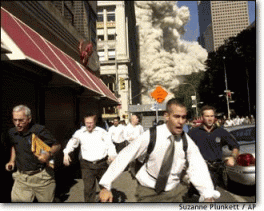NEW YORK, Sept. 11 — It was the scene of a nightmare: people on fire jumping in terror from the two World Trade Center towers just before the buildings collapsed, splinters of debris falling from the sky like surreal confetti, deadly smoke blackening the air and, in the aftermath of the devastation, an exodus of thousands of New Yorkers coated in white ash streaming on foot for hours across the city’s bridges.
The lede kept changing throughout the day. That graf is what it finally morphed into by the time I quit writing. The story ran here, but for some reason the text was not preserved except for the headline, “Nightmare scene in New York City,” and the photo, above. [Now, even the headline and photo have disappeared from the site.]
The entire story is too long to reproduce, so here’s an excerpt. (Besides, I’d rather not reprise all the horrors.)
For some downtown workers, this was a day of work that never began. “I just saw the building I work in come down,” said businessman Gabriel Ioan, in shock outside City Hall, a cloud of smoke and ash from the World Trade Center behind him. “I just saw the top of Trade Two come down.”
MSNBC.com producer Steve Johnson, standing about six blocks from the towers in lower Manhattan, was also an eyewitness to the collapse. “About five minutes before the tower fell, you could see people jumping from the upper floors. I watched six either fall or jump…. The police rolled up [in] vans. Suddenly the top of [the tower] just shattered into tens of thousands of pieces. You could see the walls peel away. The whole thing just disappeared. Then the smoke came up. The cops started yelling, ‘Get back! Run! Get away!’ I ran inside a hotel, and it went black outside because of the dust.”
And here’s an excerpt toward the end of the story:
In Brooklyn, across the East River from Manhattan, “the situation is chaos,” MSNBC.com producer Michelle Preli reported earlier in the day. “The Manhattan Bridge and Brooklyn Bridge are just full of people covered in white ash. There’s a huge smell of char in the air. People are walking with masks, with their shirts off. People are trying to get out [of the area] any way. People are crying, watching in disbelief. [It’s] total shock. It seems all the medical units, ambulances, fire services from Brooklyn [have been called in].”Although the city itself was in shock, it hadn’t really reached uptown Manhattan. On the Upper West Side, where you could see police helicopters standing in the sky like sentinels along the Hudson River, it was all eerily calm.
“There are people eating in the restaurants,” said Andras Szanto, a staff member at Columbia University. “It is a glorious sunny day — after a rainstorm of biblical proportions last night — and this perfect fall day makes it even more surreal.
“At first sight everything seems normal,” Szanto continued. “Then you notice strangers huddled around radios, students gazing at TVs in the cafes, lines at the bank for cash.”
A sign on a Starbucks coffee shop said, “Due to the terrorist attack we are closed today.”
Finally:
Five hours after the towers collapsed, people were still streaming on foot across all levels of the Manhattan Bridge as they left the disaster area.
The day after 9/11 I reported from midtown Manhattan.
NEW YORK, Sept. 12, 2001 — Times Square, the fabled crossroads of the world, was nearly deserted Wednesday. Normally packed with pedestrians and jammed with traffic, this symbol of the city’s hustle was a sleepy plaza at noon time, a day after the catastrophic attack on the World Trade Center. If you listened closely, you could hear the stop lights blink: The hush was that quiet.
Giant-sized video screens in Times Square usually play to streets filled with shutterbug tourists gawking at the neon wilderness. Not today. “They say this city never sleeps,” said Victor Tahiri, 31, standing in his Mr. Softee ice cream van. “It sleeps. Look at this. Nobody.”
MSNBC has archived the entire story here.
The week after 9/11 the stock market re-opened on Wall Street, a few blocks from Ground Zero. I reported that, too. Here’s the lede:

NEW YORK, Sept. 17 — This city’s psychological resilience, not just its commercial might, was evident Monday in the streets of Lower Manhattan as thousands of downtown workers poured into the financial district amid police cordons and military checkpoints. “It’s not about the money,” said Paul Orentlicher, a Wall Street architect who lost his best friend when terrorists leveled the World Trade Center towers last Tuesday. “I’m here to reclaim my life and to try to deal with what happened.”
MSNBC has archived the entire story here.
Had enough 9/11? I have.







